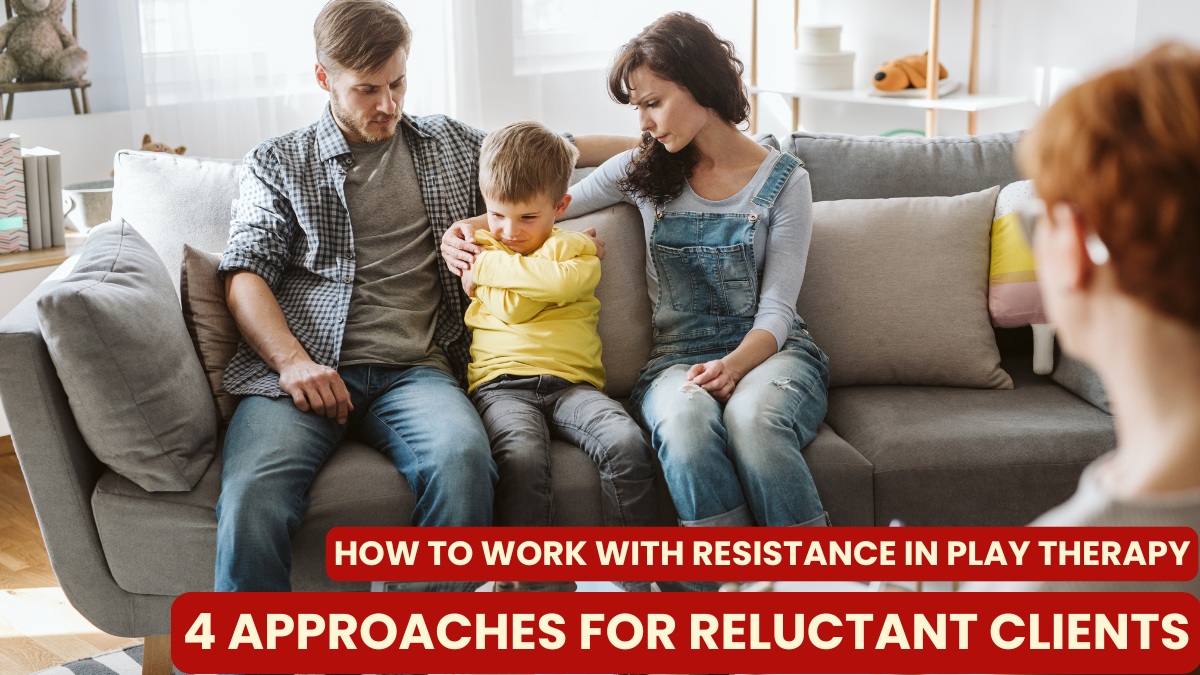How to Work with Resistance in Play Therapy: 4 Approaches for Reluctant Clients

Working with kids and families in play therapy is incredibly meaningful—but some cases can leave you emotionally drained, professionally second-guessing yourself, and wishing someone else could take over.
If you've ever found yourself saying (or thinking), “This parent is so resistant” or “This kid refuses to engage”, you're not alone. But what if the issue isn’t resistance at all?
In this episode of Next Level Play Therapy, we unpacked the misunderstood dynamic of “resistance” and explored 4 mindset and strategy shifts that can help you work with clients more effectively—without burning out.
1. Stop Saying “Resistant.” Start Asking Why They’re Reluctant.
The word resistant implies blame. It suggests the client (or their parent) is purposefully avoiding progress or trying to control the process. But when you reframe that word to reluctant, your mindset shifts.
Reluctance invites curiosity:
-
Why are they hesitant?
-
What do they need to feel safe enough to engage?
This subtle shift is powerful. Resistance says “They won’t.”
Reluctance says “They can’t yet—and I want to understand why.”
2. Set (and Communicate) Clear Expectations
A huge source of friction in therapy happens when expectations are unclear. Parents often don’t know what their role is. They bring their child in hoping you’ll “fix it,” without realizing they’re part of the process too.
Many therapists struggle here because they’ve never clarified expectations for themselves, let alone communicated them. Ask yourself:
-
How often do I expect to meet with the child?
-
How often should I meet with the parent?
-
What’s the parent's role in the change process?
-
What’s my policy for cancellations, missed sessions, or no-shows?
And most importantly: What play therapy model am I using—and why?
Your model is your GPS. It helps you know where you are in the change process, how to interpret client behavior, and what to do next.
When you're grounded in your model, you can confidently explain to caregivers why things are structured the way they are—and help them become allies in their child’s healing.
3. Understand Safety Through the Lens of Neuroscience + Attachment
What we call reluctance is often a nervous system response. Parents may feel guilt, shame, or fear of judgment. Kids may feel unsure, exposed, or confused about the therapy process.
Neuroscience and attachment theory remind us: Change requires safety. If a client doesn’t feel safe—whether consciously or unconsciously—they can’t move forward. Period.
That means your first job isn’t to “get them to comply.” It’s to build trust:
-
Be attuned to nonverbal cues.
-
Maintain congruence and presence.
-
Stay curious about what’s underneath the behavior.
-
Use your model to interpret what’s happening—and what’s needed next.
When safety is present, growth becomes possible.
4. Lean on the Power of Community (Stop Doing It Alone)
This work can be isolating. And isolation breeds self-doubt.
One of the biggest transformations therapists experience in programs like Play Therapy Elevation Circle is realizing:
-
They’re not the only one struggling.
-
They’re not doing as badly as they feared.
-
They already have more wisdom than they realize.
When you're part of a community of play therapists who truly get it, you get practical insights and emotional support. You can bring challenging cases, celebrate small wins, and stop wondering if you should switch careers after a tough session.
Therapist burnout thrives in silence and self-doubt. A community brings relief, clarity, and confidence.
Final Thoughts (and an Invitation)
If you’re dealing with clients who seem stuck—or if you feel stuck—these four shifts can change everything:
-
Reframe resistance to reluctance.
-
Set and clearly communicate expectations.
-
Anchor in safety using neuroscience and attachment.
-
Don’t do this work alone.
✨ Want help putting this into practice?
Join me for a free webinar:
How to Provide Play Therapy Without Second Guessing Every Clinical Decision—Even With Complex Cases
🗓 August 11 at 5:30 PM PT
🆓 It’s 90 minutes, completely free, and packed with value.
🔗 Register now at rhplaytherapytraining.com
And if you’re ready for ongoing support, doors to Play Therapy Elevation CIRCLEopen next week. Join the waitlist so you don’t miss out!
Categories: : Burnout, Community, Play Therapy, Play Therapy Elevation Circle, Podcast
 Cathi Spooner
Cathi Spooner 
